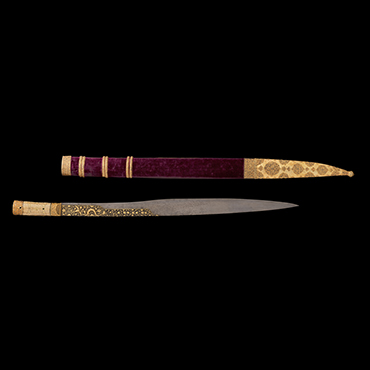Finest sword of the Islamic World
Inscribed (along the spine of the blade)
رستم عصر یل صف شکن آن گرز گران صاحب تیغ و علم احمد بن هرسک خان
The Rustam of the age, the hero that breaks the ranks (of the enemy), that wielder of the weighty mace,
The master of the sword and the standard, Ahmed b. Hersek Khan.
“این قبضه که هست مشتری مریخش، چون … چنگ ز … شد تاریخش”
This dagger, whose Mars (i.e. steel) is Jupiter,
… the harp (claw?) … became its date.
Arguably the finest sword from the Islamic world, this blade combines luxurious materials with the finest workmanship in a weapon of the highest quality. This sword is nearly identical to another smaller weapon lacking its scabbard in Metropolitan Museum of Art in New York, and a third sword in the Topkapi Palace in Istanbul, dated AH 933/1526–27 CE and signed by the craftsman Ahmad Tekkelu. It is likely that all three swords were produced by the same maker or in his workshop. Another sword of the same form but without animal carvings is now in the Museum of Islamic Art in Doha. It bears the name and titles of Bayezid II (r. AH 885–917/1481–1512 CE), making it probably the earliest of the group. These swords represent the earliest extant examples of Islamic yataghans, a type of sword characterized by its inward-curving blade, associated with the Turkic peoples since as early as the 3rd century AH/9th century CE.
The heavily gilded decoration on both sides of the blade, depicting a dragon in combat with a phoenix against a floral setting, is drawn from the visual repertoire of the Timurids of 9th-century AH/15th-century CE Iran. It may have been the work of Iranian craftsmen brought back to Istanbul after the capture of the Safavid capital Tabriz in AH 920/1514 CE.
The spine of the blade bears an inscription praising the sword as well as its intended owner, identified as Ahmad bin Hersek Khan (AH 860–923/1456–1517 CE), more commonly known as Hersekzade Ahmed Pasha. He was a younger son of the Grand Duke of Herzegovina, who converted to Islam and joined the court in Istanbul. Ahmed Pasha married the daughter of Bayezid II and held the esteemed rank of Grand Vizier four times under Bayezid II and Sultan Selim I (r. AH 917–26/1512–20 CE).This and the Doha and New York yataghans were previously owned by Rex Ingram (AH 1310–69/1893–1950 CE), an influential pioneer of cinema and prominent convert to Islam who visited Istanbul in the early 14th century AH/ 20th century CE.
Finest sword of the Islamic World
Yataghan with scabbard
Bearing the name and titles of Ahmad bin Hersek Khan
Istanbul, Türkiye, c. AH 905–20/1500–15 CE
Steel, gold, ivory, silver, rubies, niello, velvet, wood, l. 81.2 cm
Furusiyya Art Foundation, R-944

